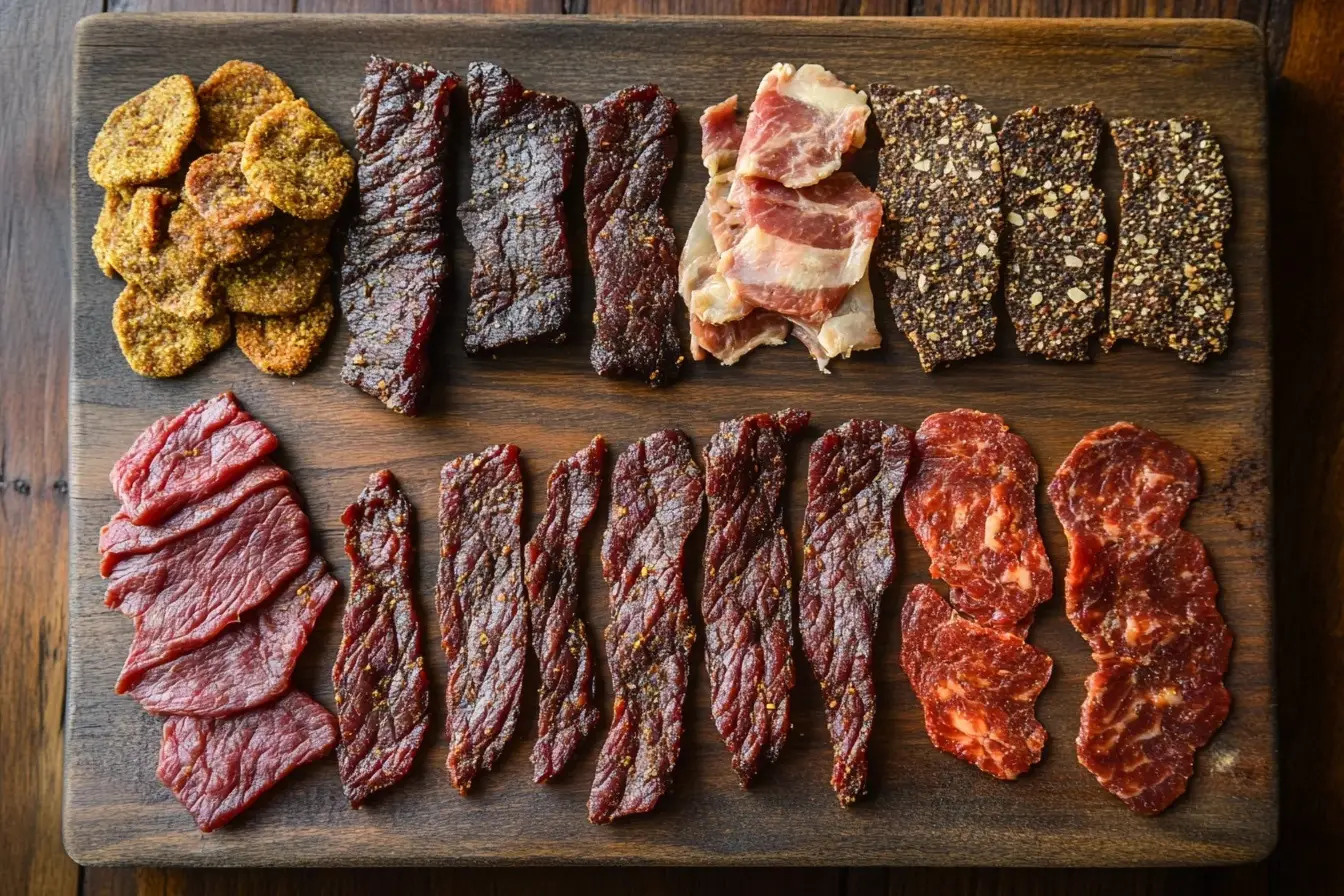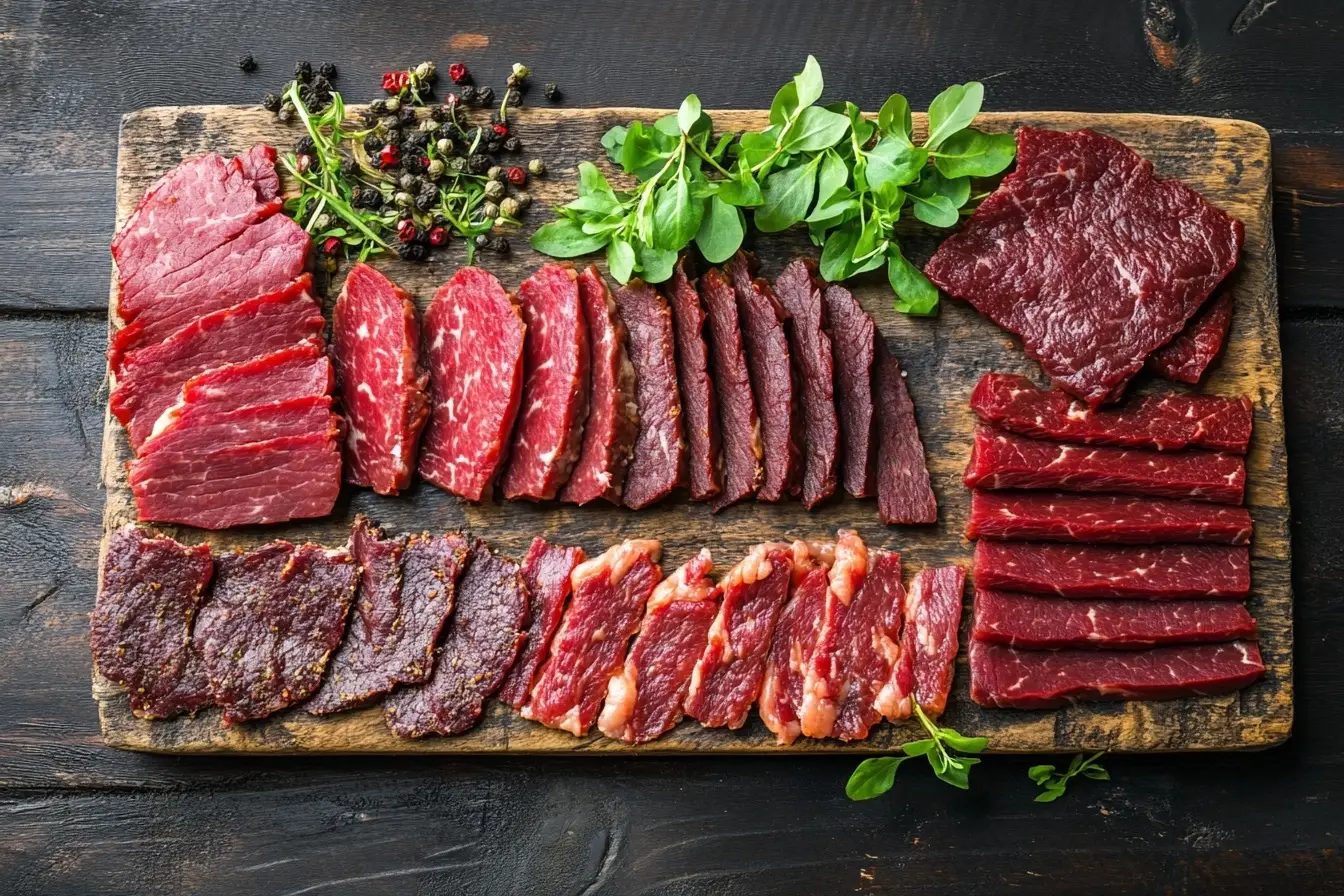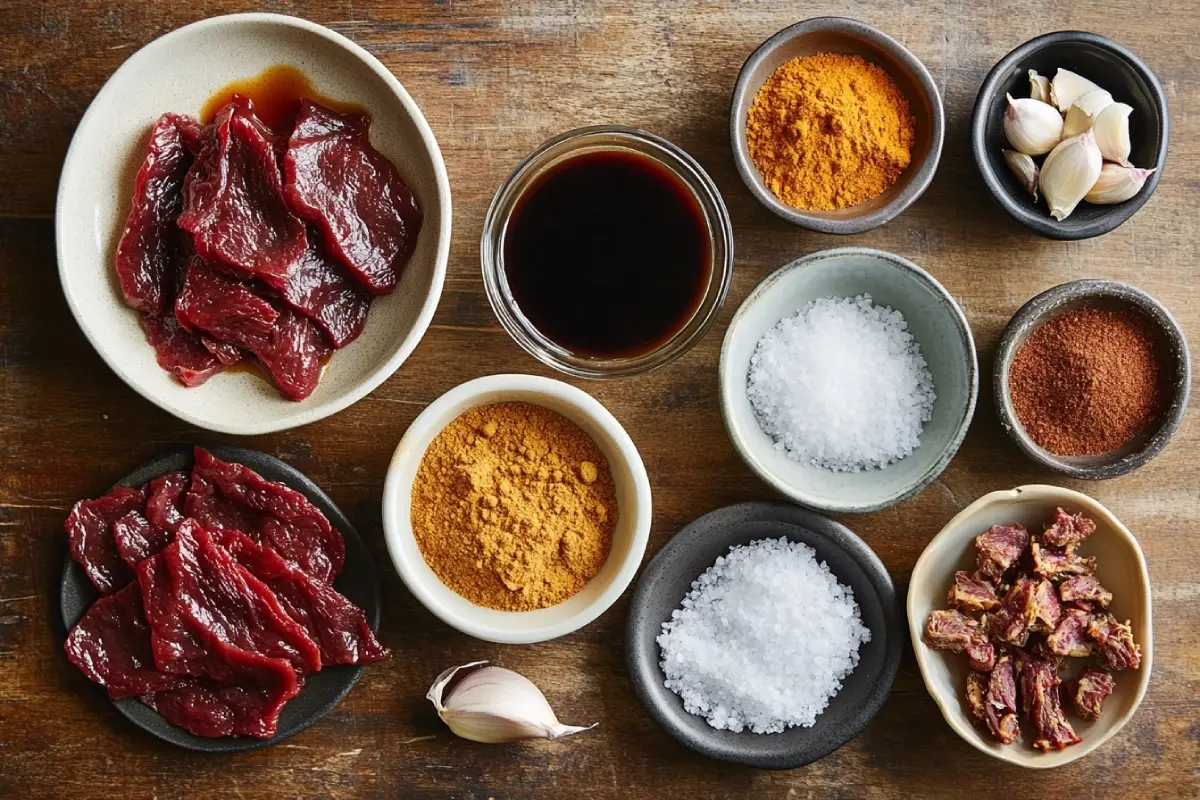Beef jerky is a favorite snack for its taste, texture, and health benefits. But have you ever thought about how it’s made? This guide will explore the history and modern production of beef jerky. We’ll look at the steps that turn simple meat into a tasty dried snack.
Key Takeaways
- Beef jerky has a rich history, with roots in ancient preservation techniques used by various cultures around the world.
- The right cut of beef is crucial for making high-quality jerky, with lean, flavorful cuts like flank steak or top round being the most common choices.
- Marinating and seasoning the meat is an essential step, allowing for a wide range of flavor profiles to be achieved.
- Dehydration is the key to transforming fresh beef into the chewy, shelf-stable jerky we know and love, with both oven drying and smoking techniques playing important roles.
- Strict quality control and food safety measures are essential throughout the jerky-making process to ensure a safe and delicious final product.
The History and Origins of Beef Jerky
The story of beef jerky goes back centuries to Native American tribes. They found a way to dry and cure meat to make it last longer. This idea spread as explorers traveled, with each culture adding their own twist.
Ancient Preservation Techniques
The term “jerky” comes from the Quechua language of the Inca in South America. They called this method “charqui.” It involved cutting meat thin, drying it in the air, and smoking it. This method was also used by Native American tribes across North America.
Beef Jerky’s Global Spread
- European explorers took up this method, making jerky a global snack.
- In the 16th century, Spanish conquistadors brought jerky to South America. It became a favorite of cowboys and ranchers.
- Jerky’s popularity grew, with new versions popping up worldwide, like biltong in South Africa and tsukudani in Japan.
Beef jerky is still a favorite snack today. It shows the creativity and food traditions of many cultures around the world.

Selecting the Right Cut of Beef
Choosing the right cut of meat is key to making great beef jerky. Look for lean, tough cuts like top round, flank steak, or brisket. These cuts have less fat and connective tissue, which is good for jerky.
Choose lean beef for jerky that’s deep red and has no extra marbling or gristle.
The best beef cuts for jerky come from the hind legs or chest. These areas are more muscular and fibrous. Stay away from fatty cuts like chuck or rib. They can make your jerky greasy and unpleasant.
| Cut of Beef | Suitability for Jerky |
|---|---|
| Top Round | Excellent |
| Flank Steak | Excellent |
| Brisket | Excellent |
| Chuck | Fair |
| Rib Eye | Poor |
By picking the right cut of beef, you’ll get jerky that’s both tasty and satisfying.

Preparing and Seasoning the Meat
Choosing the right cut of beef is just the start. Next, you need to prepare and season it for delicious beef jerky. Traditional recipes use salt, pepper, garlic, and onion powder. But, today’s jerky spice mixes are getting more creative, offering a wide range of flavors for flavored beef jerky.
Traditional Spice Blends
Classic beef jerky marinade recipes focus on a few key seasonings. A basic mix might include:
- Kosher salt
- Black pepper
- Garlic powder
- Onion powder
These seasonings, combined with the right drying, make a savory beef jerky. It’s a flavor that has lasted for ages.
Modern Flavor Innovations
The beef jerky world has seen a flavor explosion in recent years. Jerky makers are now using a wide range of ingredients. They add everything from Worcestershire sauce and liquid smoke to exotic spices and fruit juices. This makes jerky seasoning recipes almost limitless.
| Flavor Profile | Example Ingredients |
|---|---|
| Sweet and Savory | Soy sauce, brown sugar, garlic, ginger |
| Spicy | Chili powder, cayenne, paprika, habanero |
| Teriyaki | Soy sauce, brown sugar, rice vinegar, garlic, ginger |
| Barbecue | Ketchup, brown sugar, Worcestershire, smoked paprika |
With so many jerky spice mixes to try, you can make endless unique and tasty beef jerky.
The Dehydration Process
Turning raw beef into tasty, long-lasting jerky is all about dehydration. There are two main ways to do this: oven drying and using a jerky smoker. Oven drying is easier and more common, but smoking can make your jerky even better.
Oven Drying vs. Smokers
Choosing the right method is key to getting the perfect jerky. Oven drying uses a low temperature, around 155°F to 165°F, for several hours. Jerky smokers, on the other hand, use low heat and wood smoke for a unique flavor.
| Oven Drying | Smokers |
|---|---|
| More common and accessible | Adds unique smoky flavor |
| Consistent temperature control | Requires specialized equipment |
| Quicker drying time | Longer drying process |
Whether you prefer oven drying or smoky jerky, the goal is to find what works best for you. With a bit of practice, you’ll master the art of drying beef jerky.
How is beef jerky made?
The journey to making tasty beef jerky includes several important steps. These steps turn lean beef into a tasty, long-lasting snack. Whether you’re new to beef jerky or already love it, knowing how it’s made is key to making great jerky at home.
- Select the Right Cut of Beef: Pick a lean cut like flank steak or top round. It should be low in fat and good for drying.
- Slice the Meat: Cut the beef into thin, even strips. This ensures it dries evenly.
- Marinate or Season the Beef: Mix up a tasty marinade or spice blend. Coat the beef with it to add flavor.
- Dehydrate the Meat: Dry the beef slowly in an oven or smoker. Control the temperature and airflow for the right texture.
- Package and Store: Once dry, store the beef jerky in an airtight container or vacuum-sealed bag. This keeps it fresh and prevents spoilage.
Making beef jerky at home might seem simple, but it takes practice. By following these steps, you can make jerky that’s as good as store-bought.
| Step | Description |
|---|---|
| Select the Cut | Choose a lean cut of beef, such as flank steak or top round, for optimal texture and flavor. |
| Slice the Meat | Slice the beef into thin, even strips, typically between 1/4 and 1/2 inch thick. |
| Marinate or Season | Prepare a flavorful marinade or spice blend to coat the beef, infusing it with your desired seasonings. |
| Dehydrate the Meat | Use an oven or smoker to slowly dehydrate the beef, carefully controlling the temperature and airflow to achieve the perfect texture and dryness. |
| Package and Store | Once the beef jerky is fully dried, package it in an airtight container or vacuum-sealed bag to preserve freshness and prevent spoilage. |
“Making beef jerky at home is a rewarding and flavorful experience. By following the right steps, you can create a high-quality snack that satisfies your cravings and impresses your friends and family.”
Quality Control and Food Safety
Keeping beef jerky safe and of high quality is crucial. Companies must follow strict food safety rules. This includes testing for harmful bacteria like Salmonella and E. coli. They also need to handle, package, and store the jerky properly to avoid contamination.
Testing for Pathogens
Manufacturers must test the beef jerky food safety at every step. They check raw materials, samples during production, and the final product. This ensures no harmful bacteria are present. Following jerky quality standards helps give customers a safe and tasty snack.
| Pathogen | Potential Risks | Testing Procedures |
|---|---|---|
| Salmonella | Severe food poisoning, diarrhea, fever, abdominal cramps | Culturing and genetic analysis |
| E. coli O157:H7 | Bloody diarrhea, vomiting, potential kidney failure | Immunoassay and polymerase chain reaction (PCR) testing |
| Listeria monocytogenes | Listeriosis, a serious infection that can lead to hospitalization and even death | Enrichment and plating methods |
Following strict beef jerky food safety rules and jerky quality standards is key. This way, jerky makers can make sure their products are safe and of the best quality.
“Quality control and food safety are the top priorities in the production of beef jerky. Anything less than strict adherence to safety standards is unacceptable.”
Packaging and Storage
After making tasty beef jerky, it’s important to keep it fresh. The right packaging and storage are key. They help keep your homemade or store-bought beef jerky fresh and tasty.
Vacuum Sealing for Freshness
Vacuum sealing is a great way to store beef jerky. It removes air, creating a tight seal. This stops spoilage and keeps the shelf life of beef jerky longer. It’s a method used by many to keep their products fresh.
Vacuum-sealed beef jerky can last months in a cool, dry spot. It’s a great snack that stays tasty and tender. This method keeps the jerky’s flavor and texture just right.
| Packaging Method | Shelf Life |
|---|---|
| Vacuum Sealed Jerky | 2-3 Months |
| Non-Vacuum Sealed Jerky | 1-2 Weeks |
Storing jerky in a cool, dry place is also crucial. Heat, moisture, and light can damage it. So, keep it in a dark, controlled environment.
By using these simple tips, you can enjoy your beef jerky for a long time. It will stay delicious and fresh for weeks or months.
Nutritional Benefits of Beef Jerky
Beef jerky is more than just a tasty snack. It’s a rich source of high-quality protein. This protein helps build and repair muscles. It’s also low in carbs and fat, making it good for those on a keto or diabetes diet.
Beef jerky is packed with important minerals like zinc and iron. These minerals boost your immune system and fight anemia. The drying process makes jerky even more nutrient-dense, perfect for active people.
| Nutrient | Amount per Serving (1 oz) |
|---|---|
| Protein | 9-10 grams |
| Fat | 1-3 grams |
| Carbohydrates | 1-2 grams |
| Sodium | 500-750 mg |
| Zinc | 2-3 mg |
| Iron | 1-2 mg |
Beef jerky’s high sodium can be a problem. But, picking options with simple ingredients and eating small amounts can help. For a lower-sodium choice, try plant-based jerky made from soy, mushrooms, or seitan.
“Beef jerky can be a nutritious, high-protein snack option, as long as you’re mindful of portion sizes and sodium content.”
Beef Jerky Recipes and Variations
Classic beef jerky is always a hit, but you can also try new things. Use turkey, bison, or even venison to make your own special flavors. You can also play with marinades, spice mixes, and cooking ways to make it your own.
Experimenting with Different Meats
Don’t stick to just beef for your jerky. Turkey is lean and tasty, while bison is rich and slightly sweet. Venison adds a gamey, earthy flavor. Trying different meats opens up a whole new world of jerky flavors.
Looking for spicy, savory, or something in between? The secret is to try different marinades and seasonings. You can use soy sauce, Worcestershire, chili powders, and herbs to create your perfect jerky.
